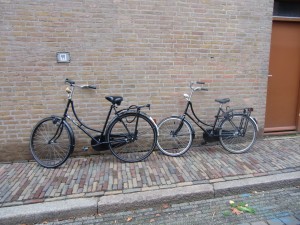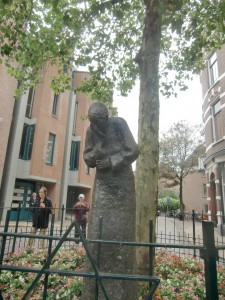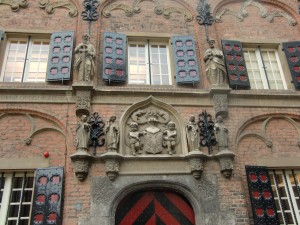CRUISING THE RHINE AND MOSEL RIVERS – ON TO HOLLAND
CRUISING THE RHINE AND MOSEL RIVERS
This is the 11th in a series of articles about cruising the Rhine and Mosel Rivers
ON TO HOLLAND
By Charles N. Stevens
Photos by Dolores Seidman
As we wake up, our boat is churning north on the Rhine, the sky streaked with clouds, a few blue patches showing through. At breakfast we see several flocks of geese flying south in their special V formations. The Rhine is very wide here, more like being on the ocean, the land around us quite flat. Barge traffic is very heavy. Cows and sheep graze in pastures and farm houses dot the land. We pass several campgrounds along the river filled with vacationers. Most of the soil is sandy, providing beaches here and there along the shore.
We pass the canal leading from the Waal River to Amsterdam then dock at the small town of Tiel in the Netherlands, one of the oldest towns in the country. While we had a little time, Dolores and I walked to town, passing through the town gates to a charming area of shops and restaurants, none of which were doing much business at this time of day. When we arrive at the main square, the town is more active with pedestrians and shoppers, people walking everywhere among the old but quaint buildings. Prominent are shops selling cheese. I sit on a bench and enjoy watching the people pass by and listening to the flow of the Dutch language. Many typical Dutch houses lined a canal, but we didn’t have time to explore them.
In early afternoon we take busses for the 40-minute trip to Nijmegen, a large Dutch city. The busses let us off near a flamboyant casino, and from there we started our walking tour. We learn that two-thirds of the Netherlands lies below sea level, only the many dykes holding back the sea. After ambling over concrete walkways, we come to a small pile of stones, artfully arranged, and said to be the last remnants of the Roman settlement that once thrived here. Nearby was an old brick and stone building with small glass panes and black shutters, the 500 year-old Besinderhuis, where a watchman once collected taxes on imports.
Climbing cobbled streets to the upper part of town, we pass a nursery school where the shouts of playing children pierce the afternoon and echo off the buildings. We wished we could have stopped and observed them more. We stroll by some of the stone defenses that once protected the town. As we entered a narrow street, we had to dodge a continuous flow of bikes, cars and motor scooters as well as joggers before we arrived at a brick synagogue. Built in 1756, it is definitely low key and blends in beautifully with the buildings around it. A statue of a Jewish girl in front stands as a memorial to the Holocaust.
Moving along, we encounter St. Stephens Church and near it, another palace of the Bishop of Cologne who seems to have had palaces everywhere. Built in 1548 to keep Catholicism safe during a rise of Protestantism, it now houses a boys’ school. We are aware that, even though Nijmegen is one of the oldest cities in the Netherlands, we see very few old buildings in the town proper, most of them having been destroyed during World War II. The story is that American bombers bombed it by mistake, thinking it was a nearby German town. Later, the Germans shelled the city for something like five weeks. Most buildings now are modern.
From the main square, we see a modern department store, HEMA, a seller of specifically Dutch goods. The green palm-shaped symbol of marijuana is prominent over several shops that sell cannabis legally, an effort to prevent the use of stronger drugs like heroin. Restrooms are very hard to come by in Europe and Nijmegen is no exception. The people at McDonalds allowed us to use there facilities, as they sometimes have in other European cities.
Dolores and I strolled down to some of the “better” parts of town, a residential area with interesting houses, more like the Dutch houses we were used to seeing on our other trips to Holland, ones with white curtains showing through sparkling-clean glass windows. We paused in front of a house where a man and his wife were decorating the outside, a brand new baby in a buggy next to them. Dolores asked them if they spoke English. The response was, “Of course.” We had a nice chat with them. Europeans always amaze us with their command of languages, especially the way most of them speak flawless English.
We found Nijmegen less interesting than most of the cities we had visited on the trip. Perhaps it is still recovering from the leveling that it endured during World War II. With half an hour still to go before the busses return, we have seen all we wanted to see.

The Dutch are great bicycle riders. These are "granny bikes" made especially for women.

This statue of a young girl standing near the Synagogue is a memorial to the Jews who perished in Germany.

We gaze up at the detail of the old buildings not devastated by war.

One of the fine old buildings off the Great Market Square.
This month Charles N. Stevens is celebrating his 90th birthday on November l8th. He is preparing to send the manuscript of his new book, “Seeking More of the Sky: Growing up in the l930’s” to the publisher.
MONTEREY PARK AUTHOR PUBLISHES 3RD BOOK ABOUT HIS EXPERIENCES IN WORLD WAR II- BACK FROM COMBAT
Charles “Norm” Stevens, a 40 year resident of Monterey Park and World War II Veteran has recently published the 3rd in his series about his experiences in WW II, Back from Combat: A WWII Bombardier Faces His Military Future. This book details the time from when he returned from combat in England where he flew 34 missions over Germany and France until the end of the war. Faced with large numbers of returning combat vets, and not knowing how long the war would continue, the military had to plan for their future. His options were whether to return to combat, become an instructor in the U.S., or receive new training that he would use in the Pacific. The book concludes with the end of the war with an Afterward that includes an update on the B-l7’s still flying in the U.S., as well as present day accounts pertaining to the war.
Stevens is the author of two previous books about his experiences:
An Innocent at Polebrook: A Memoir of an 8th Air Force Bombardier (Story of his 34 bombing missions from his base at Polebrook, England over Germany and France)
The Innocent Cadet: Becoming A World War II Bombardier (A prequel to the first, telling of his training in the U.S. before going overseas into combat.)
He is known to the readers of The Citizen’s Voice as the author of Travel Log Articles including “From Paris to Normandy on the Seine”, “Exploring New York” and “In Search of Snow.” He is retired, having taught for 32 years, primarily in the Montebello Unified School District.
Those interested in purchasing an autographed copy of any of his books, may contact the author at 323-721-8230 or Normstevens24@gmail.com.



